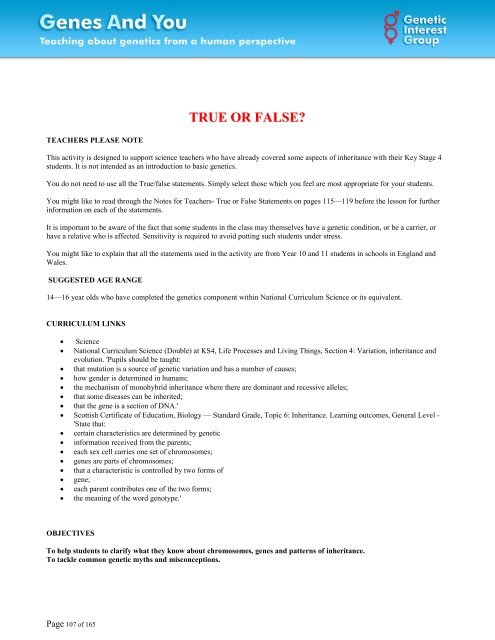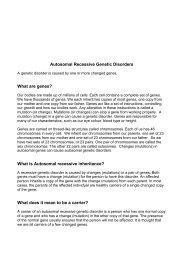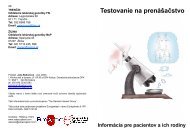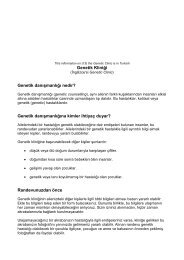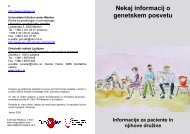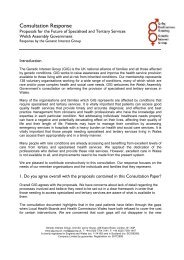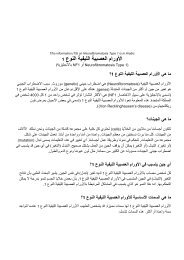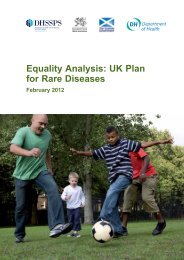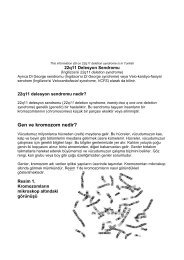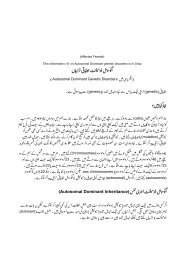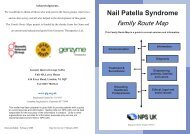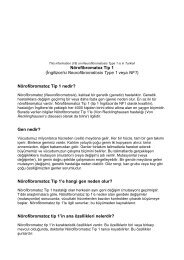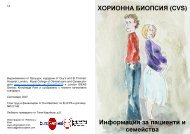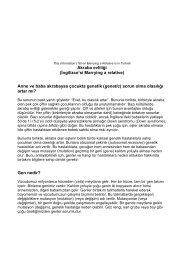TRUE OR FALSE? - Genetic Alliance UK
TRUE OR FALSE? - Genetic Alliance UK
TRUE OR FALSE? - Genetic Alliance UK
You also want an ePaper? Increase the reach of your titles
YUMPU automatically turns print PDFs into web optimized ePapers that Google loves.
<strong>TRUE</strong> <strong>OR</strong> <strong>FALSE</strong>?<br />
TEACHERS PLEASE NOTE<br />
This activity is designed to support science teachers who have already covered some aspects of inheritance with their Key Stage 4<br />
students. It is not intended as an introduction to basic genetics.<br />
You do not need to use all the True/false statements. Simply select those which you feel are most appropriate for your students.<br />
You might like to read through the Notes for Teachers- True or False Statements on pages 115—119 before the lesson for further<br />
information on each of the statements.<br />
It is important to be aware of the fact that some students in the class may themselves have a genetic condition, or be a carrier, or<br />
have a relative who is affected. Sensitivity is required to avoid putting such students under stress.<br />
You might like to explain that all the statements used in the activity are from Year 10 and 11 students in schools in England and<br />
Wales.<br />
SUGGESTED AGE RANGE<br />
14—16 year olds who have completed the genetics component within National Curriculum Science or its equivalent.<br />
CURRICULUM LINKS<br />
• Science<br />
• National Curriculum Science (Double) at KS4, Life Processes and Living Things, Section 4: Variation, inheritance and<br />
evolution. 'Pupils should be taught:<br />
• that mutation is a source of genetic variation and has a number of causes;<br />
• how gender is determined in humans;<br />
• the mechanism of monohybrid inheritance where there are dominant and recessive alleles;<br />
• that some diseases can be inherited;<br />
• that the gene is a section of DNA.'<br />
• Scottish Certificate of Education, Biology — Standard Grade, Topic 6: Inheritance. Learning outcomes, General Level -<br />
'State that:<br />
• certain characteristics are determined by genetic<br />
• information received from the parents;<br />
• each sex cell carries one set of chromosomes;<br />
• genes are parts of chromosomes;<br />
• that a characteristic is controlled by two forms of<br />
• gene;<br />
• each parent contributes one of the two forms;<br />
• the meaning of the word genotype.'<br />
OBJECTIVES<br />
To help students to clarify what they know about chromosomes, genes and patterns of inheritance.<br />
To tackle common genetic myths and misconceptions.<br />
Page 107 of 165
A C T I V I T Y S U P P O R T : T E A C H E R S ’ N O T E S T R U E O R<br />
F A L S E ?<br />
USING THE ACTIVITY WITH STUDENTS<br />
You can use this activity in a number of ways:<br />
Read out the True/False statements which you have selected asking students to stand up if they think they are True. Ask students to<br />
keep their own score.<br />
<strong>OR</strong><br />
Divide students into groups of three. Give each group a set of the cut-out statements you have selected and ask them to sort the<br />
statements into three piles: <strong>TRUE</strong>, <strong>FALSE</strong> and NOT SURE.<br />
You can use the additional information in the Notes for Teachers — True/False Statements to help you process the activity.<br />
If you have any time left over at the end of the lesson, you could ask students to discuss one or more of the following statements.<br />
The first statement is from a Year 11 student (15/16 years old) and the second and third statements are from students in Year 10<br />
(14/15 years old):<br />
'<strong>Genetic</strong>s is an important field of science because it can lead to the development of better, healthier people.'<br />
'One person's genes are nobody else's business.'<br />
'Today an unhealthy gene can be replaced with a healthy gene.'<br />
A brief commentary on each statement is included below for teacher reference.<br />
<strong>Genetic</strong>s is an important field of science because it can lead to the development of better, healthier people.<br />
EXTENDING KNWLEDGE<br />
It could be said that the main purpose of genetic research is to extend our knowledge about genes and how they work in order to<br />
develop better, more effective ways of treating people with a genetic disorder and find ways of eliminating genetic disease<br />
altogether. However, it is important to distinguish between the use of the word 'better' meaning 'healthier1, and 'better' meaning<br />
morally or physically superior to others.<br />
Many people (including scientists) feel uncomfortable with the idea of genetics being used to create 'perfect' babies or 'improve' the<br />
human race and are rightly concerned that genetic technology should develop in a morally and socially responsible way. In the <strong>UK</strong>,<br />
all research into human genetics must be cleared with an ethical committee before it can begin.<br />
One person's genes are nobody else's business.There are times when it might be important for people to reveal genetic information<br />
about themselves (for example if a would-be train driver is colour blind, or a woman with brothers and sisters of reproductive age<br />
gives birth to a child with a genetic disorder). But there is a delicate and complex balance to strike between the rights of individuals<br />
to keep genetic information to themselves and the rights of other family members/the general public to have access to this<br />
information for their own health care and/or safety.<br />
Many people face prejudice and discrimination if they tell insurance or mortgage companies, banks and employers that they have,<br />
or are likely to develop, a genetic disorder. Until there is effective legislation which protects confidentiality and prevents the misuse<br />
of genetic information, some people might want to agree with the statement: Today an unhealthy gene can be replaced with a<br />
healthy gene.<br />
Scientists are trying to do something like this in a form of treatment known as gene therapy. This is an experimental technique in<br />
which specially engineered viruses, or in some cases fatty particles called liposomes, are used to carry working copies of a gene<br />
into the relevant part of a person's body (e.g. the lungs of a person with cystic fibrosis, or the muscles of a boy with Duchenne<br />
muscular dystrophy).<br />
Page 108 of 165
A C T I V I T Y S U P P O R T : T E A C H E R S ’ N O T E S T R U E O R<br />
F A L S E ?<br />
The idea is to compensate for a missing or faulty gene by introducing working copies of that gene which will then help the affected<br />
cells to produce the protein they need to function properly.<br />
So functional copies of the gene are made in a laboratory. These genes have to be inserted into the viruses or liposomes which carry<br />
them into the right cells. Those cells have to accept the new genes which then have to work properly. Although scientists have in<br />
some cases succeeded in getting working copies of a particular gene to the right cells, they have not yet found an effective way of<br />
getting them to function properly for any length of time.<br />
OPTIONAL FOLLOW-UP ACTIVITIES<br />
Select three of the <strong>FALSE</strong> statements used in class (or ask students to choose three themselves). Students could then be asked to<br />
write down what is wrong with the<br />
statements and why.<br />
Students could be given some of the statements which were not used in class and asked to write down whether they think they are<br />
True or False and why.<br />
Students could be given some of the statements not used in class together with a copy of the matching Notes for Teachers — True<br />
or false Statements (photocopied and cut out so that only the explanation is left, not the statement itself nor whether it is True or<br />
False). The students then have to decide (a) whether each statement is True or False and (b) which explanation goes with which<br />
statement.<br />
1. A gene is a length of DNA.<br />
<strong>TRUE</strong><br />
See pages 112-116 for notes on each statement<br />
2. There is such a thing as a longevity gene which enables you to live up to 30% longer than the average human.<br />
<strong>FALSE</strong><br />
3. Identical twins have the same genes.<br />
<strong>TRUE</strong><br />
4. Tongue-rolling is genetic-you can either do it or you can't.<br />
<strong>TRUE</strong><br />
5. If your mother is the only girl and has seven brothers and your father is one of seven boys, you are more likely to have a boy.<br />
<strong>FALSE</strong><br />
6. Genes are part of a human's body which give out emotions.<br />
<strong>FALSE</strong><br />
7. if you're homosexual, it's because you've got a gay gene.<br />
<strong>FALSE</strong><br />
8. Genes are passed down through your biological parents.<br />
<strong>TRUE</strong><br />
9. There are 23 chromosomes in a gene.<br />
<strong>FALSE</strong><br />
10. Genes contain chromosomes.<br />
<strong>FALSE</strong><br />
Page 109 of 165
A C T I V I T Y S U P P O R T : T E A C H E R S ’ N O T E S T R U E O R<br />
F A L S E ?<br />
11. Half your genes come from your mother and half from your father.<br />
<strong>TRUE</strong><br />
12. Genes can mutate.<br />
<strong>TRUE</strong><br />
13. <strong>Genetic</strong> disorders are always passed on.<br />
<strong>FALSE</strong><br />
14. The severity of genetic diseases decreases as they are passed through the generations.<br />
<strong>FALSE</strong><br />
15. fhere are 46 chromosomes in all normal cells except gametes (sex cells) which have 23 chromosomes.<br />
<strong>TRUE</strong><br />
16. Ail genetic disorders are recessive.<br />
<strong>FALSE</strong><br />
17. If you have faulty genes, you have some kind of disability, no matter how slight.<br />
<strong>FALSE</strong><br />
18. Genes are found on thread-like chromosomes in the nucleus of every cell.<br />
<strong>TRUE</strong><br />
19. Everyone has a 'DNA fingerprint' which can be used to identify people i.e. in crime.<br />
<strong>TRUE</strong><br />
20. DNA can be affected by exposure to radiation.<br />
<strong>TRUE</strong><br />
21. You inhabit genes from parents and that's how you get certain habits from them.<br />
<strong>FALSE</strong><br />
22. Genes determine everything about you.<br />
<strong>FALSE</strong><br />
23. DNA stands for deoxyribonucleic acid.<br />
<strong>TRUE</strong><br />
24. Genes are passed on through blood.<br />
<strong>FALSE</strong><br />
25. There are 4 types of genes - C, T, A, G.<br />
<strong>FALSE</strong><br />
26. DNA can replicate.<br />
<strong>TRUE</strong><br />
27. Your genes are inherited by your parents.<br />
<strong>FALSE</strong><br />
28. There are 46 genes in every living cell.<br />
<strong>FALSE</strong><br />
29. Humans can use their knowledge of genetics to look for a cure for genetic diseases.<br />
<strong>TRUE</strong><br />
Page 110 of 165
A C T I V I T Y S U P P O R T : T E A C H E R S ’ N O T E S T R U E O R<br />
F A L S E ?<br />
30. It is now possible for doctors to create the perfect baby, removing any wrong ones.<br />
<strong>FALSE</strong><br />
31. Genes come equipped with buttons or zips, sometimes a belt and very rarely with stones in their pockets.<br />
<strong>FALSE</strong><br />
32. A genetic description is called a 'genotype'. The physical description is called a 'phenotype'.<br />
<strong>TRUE</strong><br />
33. If two recessive genes for an illness are inherited you are likely to get it.<br />
<strong>TRUE</strong><br />
34. Sex cells only contain one gene.<br />
<strong>FALSE</strong><br />
35. Write your own statement here;<br />
36. Write your own statement here:<br />
Page 111 of 165
A C T I V I T Y S U P P O R T : T E A C H E R S ’ N O T E S T R U E O R<br />
F A L S E ?<br />
<strong>TRUE</strong><br />
<strong>TRUE</strong> <strong>OR</strong> <strong>FALSE</strong> STATEMENTS<br />
1. .A gene is a length of DNA<br />
.<br />
<strong>TRUE</strong>. DNA (deoxyribonucleic acid) is found in the nucleus of nearly every cell in the human body. Genes are sections of DNA<br />
which carry instructions for building new life. There are thought to be approximately 100,000 pairs of genes in human DNA.<br />
2. .Identical twins have the same genes.<br />
<strong>TRUE</strong>. Identical twins are the result of a single fertilised egg cell (ovum) dividing into two. As both embryos come from the same<br />
fertilised egg they share the same DNA (in the form of chromosomes) and therefore the same genes (situated along the<br />
chromosomes). So identical twins are always both boys or both girls and look almost exactly the same as each other. Non-identical<br />
twins are the result of two independent egg cells being fertilised at the same time. As the egg cells are fertilised by different sperm,<br />
the embryos do not share the same DNA and the two babies which develop may be different sexes and look different too.<br />
3. .Tongue-rolling is genetic — you can either do it or you can't.<br />
<strong>TRUE</strong> Tongue-rolling is an inherited characteristic. If you do not inherit the gene, you will not be able to roll your tongue, no<br />
matter how hard you try. Tongue-rolling is an example of discontinuous variation (there are only two variants — people who can<br />
roll their tongues and people who can't). Other inherited characteristics such as height are examples of continuous variation (there<br />
are many variants, from very short right through to very tall).<br />
4. Genes are passed down through your biological parents.<br />
<strong>TRUE</strong>. When the egg cell from your biological mother was fertilised by a sperm cell from your biological father, the chromosomes<br />
from each parent came together to form the blueprint from which you developed. But although your physical characteristics are<br />
largely determined by the genes you inherited from your biological parents, many other influences can affect how you grow and<br />
develop. So if you no longer live with your biological parents, the people who look after you and the environment you live in can<br />
affect the kind of person you are, your health, your self-esteem and your general well-being.<br />
5. Half your genes come from your mother and half from your father.<br />
<strong>TRUE</strong>. When a sperm fertilises an egg cell, the 23 chromosomes from each parent come together to make up the 46 chromosomes<br />
needed for the development of a new and unique human being. Genes are situated along these chromosomes, and one of each pair<br />
of genes comes from the mother and the other from the father.<br />
6. Genes can mutate.<br />
<strong>TRUE</strong>. This is a major source of genetic variation. Changes to the structure of DNA (mutations) can occur when DNA is copying<br />
itself - perhaps some of the letters in the genetic code change places, or get left out or copied too many times. These altered genes<br />
are then passed on to the next generation. Mutations can occur naturally but their frequency is greatly increased by mutagens<br />
(certain chemicals and types of radiation). Some mutations prove to be beneficial. Others are harmful but may not be passed on if<br />
they cause early death or place an individual at a severe disadvantage in a particular environment.<br />
7. There are 46 chromosomes in all normal cells except gametes (sex cells) which have 23 chromosomes.<br />
<strong>TRUE</strong>. The 23 chromosomes in each sperm and egg cell come together at fertilisation to make the 46<br />
chromosomes needed for the development of a new human being.<br />
8. Genes are found on thread-like chromosomes in the nucleus of every cell.<br />
<strong>TRUE</strong>. There are approximately 100,000 pairs of genes to be found along the 46 chromosomes which exist in the nucleus of most<br />
human body cells.<br />
Page 112 of 165
A C T I V I T Y S U P P O R T : T E A C H E R S ’ N O T E S T R U E O R<br />
F A L S E ?<br />
<strong>TRUE</strong> continued<br />
9. Everyone has a 'DNA fingerprint' which can be used to identify people i.e. in crime.<br />
<strong>TRUE</strong>. A person's DNA contains regions which code for specific proteins (genes) and regions which do not code for anything.<br />
Some of these non-coding regions are unique to each individual and can be used to distinguish between people<br />
Alec Jeffreys, the British professor who developed the technique of genetic fingerprinting, claimed that if someone gave him two<br />
DNA samples from different people, he could 'easily and repeatedly' distinguish them unless they came from identical twins.<br />
Identical twins share the same DNA (see answer to 3: <strong>TRUE</strong>) but everyone else's DNA is unique<br />
So a genetic 'fingerprint' (which is not a fingerprint at all, but a 'picture' prepared by cutting, sorting and staining fragments of<br />
DNA so they can be 'read' like a bar code) can be used to see whether the DNA taken from body fluids at the scene of a crime<br />
matches the DNA of the suspect. The degree to which courts rely on DNA fingerprinting as evidence varies from country to<br />
country.<br />
<strong>Genetic</strong> 'fingerprints' are also used in immigration and paternity cases. A child inherits half its DNA from one parent and half from<br />
the other, so scientists look to see if a child's own genetic 'fingerprint' matches part of its father's and part of its mother's. Close<br />
relatives can also be identified in this way as they will share a part of their DNA.<br />
10. DNA can be affected by exposure to radiation.<br />
<strong>TRUE</strong>. Our genes are continually being bombarded by different forms of background radiation (i.e. solar radiation, radiation from<br />
uranium and thorium in the soil and from radioactive potassium, phosphorus and calcium within our bodies). In most cases, our<br />
bodies have developed ways of coping with these kinds of radiation, although the thinning of the ozone layer means that we are<br />
being exposed to more unfiltered radiation from the sun than many of us are used to, which can cause our genes to mutate (change)<br />
and which increases the incidence of skin cancer<br />
Some of us routinely come into contact with radiation as part of our health care (e.g. through medical or dental X-rays). Radiation<br />
is also used to treat cancer, and radioactive tracer materials injected into the body can aid medical diagnosis. Some people will have<br />
contact with radioactive materials in the workplace. A few will be subjected to radioactive fallout from nuclear tests and from<br />
major nuclear disasters such as Chernobyl. Uncontrolled or unsafe exposure to radiation can cause mutations in the DNA in our<br />
body cells and in our reproductive cells, which can mean that damage from radiation can continue into the next generation.<br />
11. DNA stands for deoxyribonucleic acid.<br />
<strong>TRUE</strong>.<br />
12. DNA can replicate.<br />
<strong>TRUE</strong>. Before a cell divides, the chromosomes (which are made up of very long strands of DNA) are replicated (copied). The<br />
DNA molecule is a double helix (imagine a ladder twisted round into a spiral with rungs made up of pairs of organic bases). To<br />
replicate, the DNA first separates into two strands (imagine someone cutting the ladder in two right down the middle, leaving the<br />
long support on each side with rungs sticking out). Then molecules containing more organic bases are attached to the open ends of<br />
these rungs. They can only do this in a certain way — if the open end is the base adenine, thymine will pair up with it (and vice<br />
versa). If the open end is the base cytosine, guanine will pair up with it (and vice versa). In this way, two exact copies of the<br />
original DNA are produced.<br />
13. Humans can use their knowledge of genetics to look for a cure for genetic diseases.<br />
<strong>TRUE</strong>. Some doctors and scientists would argue that this is the main purpose of genetic research, although curing genetic disease<br />
is difficult. Even where a cure is not likely, knowing about genes and how they work makes it easier to develop more effective drug<br />
and other treatments for specific genetic disorders.<br />
Page 113 of 165
A C T I V I T Y S U P P O R T : T E A C H E R S ’ N O T E S T R U E O R<br />
F A L S E ?<br />
<strong>TRUE</strong> continued<br />
14. A genetic description is called a 'genotype'. The physical description is called a 'phenotype'.<br />
<strong>TRUE</strong>. So one can describe a person's eye colour in two different ways:a) 'Tania has brown eyes' (Tania's phenotype)b) 'Tania is<br />
BB or Bb' (Tania's genotype, where 'B' represents the gene for brown eyes and V the gene for blue eyes).<br />
15. If two recessive genes for an illness are inherited you are likely to get it.<br />
<strong>TRUE</strong>. If a person inherits two recessive genes for a genetic disorder, that person is likely to develop the disorder. Genes work in<br />
pairs. We get one copy from our mother and one copy from our father. So if you inherit one faulty and one working copy of a<br />
recessive gene, you will not develop the disorder because the working copy functions normally and hides the effects of the faulty<br />
gene. You will, however, be a carrier of that disorder (i.e. you can pass the faulty gene onto any children you may have). But if you<br />
inherit two recessive genes for a disorder (one from each parent), you have no working copies of the gene and will develop that<br />
disorder.<br />
16. There is such a thing as a longevity gene which enables you to live up to 30% longer than the average human.<br />
<strong>FALSE</strong>. No-one has yet located a gene/group of genes which appear to increase the lifespan of humans, although there is evidence<br />
for genes which act in this way in fruit flies.<br />
17. If your mother is the only girl and has seven brothers and your father is one of seven boys, you are more likely to have a boy.<br />
<strong>FALSE</strong>. The fact that boys 'run in the family' does not affect the chances of you having a boy or a girl. The sex of a baby is<br />
genetically determined by the chromosomes it receives from its parents at fertilisation. All the mother's egg cells contain 22<br />
chromosomes plus an X chromosome. The sex of the baby depends on whether the female egg cell (ovum) is fertilised by a sperm<br />
carrying an X or Y chromosome. As roughly half of the father's sperm cells contain 22 chromosomes plus an X chromosome and<br />
half contain 22 chromosomes plus a Y chromosome, the chances of the baby being male or female are equal:<br />
X (from the mother) + X (from the father) = XX (a girl ♀) X (from the mother) + Y (from the father) = XY (a boy ♂)<br />
18. Genes are part of a human's body which give out emotions.<br />
<strong>FALSE</strong>. Genes determine a person's physical characteristics. They cannot be said to 'give out emotions'.<br />
19. If you're homosexual, it's because you've got a gay gene.<br />
<strong>FALSE</strong>. Homosexuality may be genetic in origin, but evidence to support this theory has so far been inconclusive. In America in<br />
1993, Dr. Dean Hamer claimed to have linked male homosexuality to a region of the X chromosome called Xq28. He extended his<br />
research in 1995 with a small study based on 33 sets of brothers, all of whom were homosexual. The study showed that 22 out of<br />
the 33 pairs (67%) shared the Xq28 DNA sequences, while among their heterosexual brothers (from 11 families) the estimated<br />
level of Xq28 sequence sharing was only 22°/o. But 36 pairs of sisters, all of whom were<br />
lesbian, showed no significant sharing of any of the locations tested. The researchers conclude, 'It is highly unlikely that any single<br />
genetic variation or allele will be present in all homosexual individuals or absent from all heterosexual individuals.' Researchers<br />
working with other groups of gay men have so far failed to repeat Hamer's results.<br />
20. There are 23 chromosomes in a gene.<br />
<strong>FALSE</strong>. This is impossible as chromosomes are made up of genes! Scientists are not yet sure exactly how many genes are situated<br />
along the 46 chromosomes found in human cells, but 100,000 pairs is a commonly quoted figure. (N.B. If the Year 11 student who<br />
made this statement had written 'There are 23 chromosomes in each human sex cell', she would have been right.)<br />
Page 114 of 165
A C T I V I T Y S U P P O R T : T E A C H E R S ’ N O T E S T R U E O R<br />
F A L S E ?<br />
21. Genes contain chromosomes.<br />
<strong>FALSE</strong>. It is the other way round — chromosomes contain genes.<br />
22. <strong>Genetic</strong> disorders are always passed on.<br />
<strong>FALSE</strong>. It is important to distinguish here between a parent with a genetic disorder passing that particular disorder onto his/her<br />
child, and a parent who is not affected but is a carrier passing on a faulty copy of a gene. The answer below explores how disorders<br />
are passed on by affected parents (see answer to 16:<br />
for further information about dominant and recessive genes). Whether a genetic disorder is passed on or not depends on a number<br />
of things:a) If the person with a genetic disorder decides not to have children, he/she will not pass on the disorder.b) If a person<br />
with a genetic disorder decides to have children, the chances of passing on the disorder will vary: If one parent has a dominant<br />
disorder (e.g. tuberous sclerosis, neurofibromatosis, Huntington's disease etc.) each (and every) child of theirs has a 50°/o chance of<br />
being affected by the disorder.<br />
If one parent has a recessive disorder (e.g. sickle cell anaemia, thalassaemia, cystic fibrosis, Friedreich's ataxia etc.) each (and<br />
every) child of theirs will be a carrier of the faulty gene but will not develop the disease unless (s)he has also inherited a second<br />
copy of the faulty gene from the other parent.<br />
If the father has an X-linked disorder (e.g. haemophilia) each daughter will be a carrier of the faulty gene, but each son will be<br />
neither a carrier nor have the disorder (unless his mother is a carrier, in which case he could inherit the faulty gene on her X<br />
chromosome and be affected by the disorder).<br />
This is the sort of information which genetic counsellors offer people at risk of having a child affected by a genetic disorder<br />
.<br />
23. The severity of genetic diseases decreases as they are passed through the generations.<br />
<strong>FALSE</strong>. It is true that some genetic conditions (such as tuberous sclerosis) show variable effects and degrees of 'severity' even<br />
within the same family. But there is no evidence to suggest that genetic diseases become less severe as they pass through the<br />
generations<br />
.<br />
24. All genetic disorders are recessive.<br />
<strong>FALSE</strong>. Some genetic disorders are autosomal dominant. 'Autosomal' means that the gene can be on any chromosome except the<br />
sex chromosomes. 'Dominant' means that a person with one faulty and one working copy of the gene for a particular disorder will<br />
be affected by the disorder because the faulty copy of the gene is dominant over the working copy. Examples of autosomal<br />
dominant disorders include Huntington's disease, neurofibromatosis, and familial polycystic kidney disease.<br />
Some genetic conditions are autosomal recessive. A person who has inherited two faulty copies of the gene for a recessive disorder<br />
(one from each parent) and no working copies of the gene will be affected by that disorder. A person with one working copy and<br />
one faulty copy of the gene for a recessive disorder will not have the condition but will be a carrier and could pass the faulty copy<br />
of the gene onto any children they may have. Examples of autosomal recessive conditions include cystic fibrosis, phenylketonuria<br />
(PKU), sickle cell anaemia and thalassaemia.<br />
Some genetic conditions are X-linked. Generally speaking, only males are affected by X-linked conditions. This is because males<br />
only have one copy of the X chromosome while females have two copies. If there is a faulty gene on an X chromosome, the effects<br />
will not be seen in females because they usually have a working copy on their other X chromosome. But males are affected by the<br />
disorder if there is a faulty gene on their X chromosome because the Y chromosome does not contain a copy of that gene. Examples<br />
of X-linked conditions include haemophilia, Duchenne muscular dystrophy and Fragile X.<br />
Page 115 of 165
A C T I V I T Y S U P P O R T : T E A C H E R S ’ N O T E S T R U E O R<br />
F A L S E ?<br />
25. If you have faulty genes, you have some kind of disability, no matter how slight.<br />
<strong>FALSE</strong>. Everybody carries a few copies of genes that do not work well. However all of our genes come in pairs (alleles) and in<br />
most cases, one working copy of each gene is sufficient (see answer to 16: <strong>FALSE</strong> for some exceptions to this).<br />
26. You inherit genes from parents and that's how you get certain habits from them.<br />
<strong>FALSE</strong>. You inherit genes from your parents, not habits (although the way your parents live may well influence how you develop<br />
and the habits you form).<br />
27. Genes determine everything about you.<br />
<strong>FALSE</strong>. It is True that genes determine physical characteristics such as hair and eye colour, but they do not determine everything<br />
about you. Environmental factors also influence how you develop. For example, your weight will be affected by how much you eat<br />
and how much exercise you take, while how clever you are and the talents and skills you develop will depend on many things such<br />
as how much encouragement you get and what opportunities you have to learn and to practise.<br />
28. Genes are passed on through blood.<br />
<strong>FALSE</strong>. Genes are passed through the sex cells (the egg and the sperm). When an egg is fertilised by a sperm and then divides you<br />
can say that the genes have been passed on. So expressions like 'It's in the blood', 'Bad blood,1 or, 'Their bloods don't mix well1 are<br />
misleading.<br />
29. There are four types of genes — C, T, A, G.<br />
<strong>FALSE</strong>. The letters C, T, A and G stand for cytosine, thymine, adenine and guanine, which are the four organic bases in the centre<br />
of the DNA molecule. These bases are paired together — A with T and C with G. Genes vary in size, but a typical gene may be<br />
made up of a few thousand of these base pairs (although some genes may be much bigger or smaller than this)<br />
30. Your genes are inherited by your parents.<br />
<strong>FALSE</strong>. Your genes are inherited from your parents.<br />
31. There are 46 genes in every living cell.<br />
<strong>FALSE</strong>. There are 46 chromosomes in the nucleus of almost all the cells in the body. It is estimated that there are about 100,000<br />
pairs of genes situated along these chromosomes<br />
32. It is now possible for doctors to create the perfect baby, removing any wrong ones.<br />
<strong>FALSE</strong>. It is not possible for doctors to guarantee that a baby will be born healthy. They can, however, offer pregnant women a<br />
range of prenatal tests to try and identify whether their baby is developing normally. Where there is a family history of a particular<br />
genetic disorder, they may also be able to offer a specific test to see if the fetus is affected by that condition, although not many<br />
such tests exist (remember that we have approximately 100,000 pairs of genes).If a baby is found to be affected during pregnancy<br />
through routine screening or prenatal testing, the couple will have the option of termination, but the final decision is left to them. So<br />
doctors cannot create 'perfect' babies, nor can they decide to get rid of any 'wrong' ones.<br />
33. Genes come equipped with buttons or zips, sometimes a belt and very rarely with stones in their pockets.<br />
<strong>FALSE</strong>. Jeans do, genes don't!<br />
34. Sex cells only contain one gene.<br />
<strong>FALSE</strong>. Sex cells (i.e. sperm and egg cells) contain approximately 100,000 genes, spread along 23 chromosomes.<br />
Page 116 of 165
A C T I V I T Y S U P P O R T : T R U E O R F A L S E ?<br />
<strong>TRUE</strong> <strong>OR</strong> <strong>FALSE</strong> STATEMENTS F<strong>OR</strong> STUDENTS<br />
PHOTOCOPY, CUT UP AND PLACE SELECTED STATEMENTS IN AN ENVELOPE<br />
(ONE ENVELOPE PER GROUP OF THREE STUDENTS).<br />
<strong>TRUE</strong> <strong>OR</strong> <strong>FALSE</strong> STATEMENTS<br />
1. A gene is a length of DNA<br />
2. There is such a thing as longevity<br />
3. Identical twins have the same genes.<br />
4. Tongue-rolling is genetic — you can either do it or you can't.<br />
5.<br />
If your mother is the only girl and has seven brothers and your father is one of seven boys, you<br />
are more likely to have a boy.<br />
6. Genes are part of a human's body which give out emotions<br />
7. If you're homosexual, it's because you've got a gay gene.<br />
8. Genes are passed down through your biological parents.<br />
9. There are 23 chromosomes in a gene.<br />
Page 117 of 165
10. Genes contain chromosomes.<br />
11. Half your genes come from your mother and half from your father.<br />
12. Genes can mutate.<br />
13. <strong>Genetic</strong> disorders are always passed on.<br />
14. The severity of genetic diseases decreases as they are passed through the generations.<br />
15.<br />
There are 46 chromosomes in all normal cells except gametes (sex cells) which have 23<br />
chromosomes.<br />
16. All genetic disorders are recessive.<br />
17. If you have faulty genes, you have some kind of disability, no matter how slight.<br />
18. Genes are found on thread-like chromosomes in the nucleus of every cell.<br />
19. Everyone has a 'DNA fingerprint' which can be used to identify people i.e. in crime.<br />
20. DNA can be affected by exposure to radiation.<br />
21. You inhabit genes from parents and that's how you get certain habits from them<br />
22. Genes determine everything about you.<br />
23. DNA stands for deoxyribonucleic acid<br />
24. Genes are passed on through blood.<br />
25. There are 4 types of genes — C,T, A,G.<br />
26. DNA can replicate.<br />
Page 118 of 165
27. Your genes are inherited by your parents<br />
28. There are 46 genes in every living cell.<br />
29. Humans can use their knowledge of genetics to look for a cure for genetic diseases.<br />
30. It is now possible for doctors to create the perfect baby, removing any wrong ones.<br />
31.<br />
Genes come equipped with buttons or zips, sometimes a belt and very rarely with stones in their<br />
pockets.<br />
32. A genetic description is called a 'genotype'. The physical description is called a 'phenotype'.<br />
33. If two recessive genes for an illness are inherited you are likely to get it<br />
34. Sex cells only contain one gene<br />
Write your own statement here:<br />
Page 119 of 165


